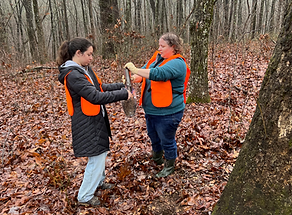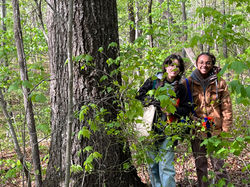
Long-Term Forest Dynamics in Two Mature Forested Watersheds on the Cumberland Plateau, TN
Non-equilibrium theory of forest dynamics suggests that forest communities may never actually attain a steady-state (climax) pattern of community composition, structure and function over time. Instead, forest communities are constantly in the process of responding to the last disturbance event, putting them on a constant and unpredictable trajectory of community change. This theory may be particularly relevant to our contemporary understanding of Southern Appalachian forests which, over the last 100 years, have experienced the compounded effects of major anthropogenic influences including: fire suppression, deer overpopulation, introduced pathogens, timber harvesting and acid rain.




In this study, we are examining 5 decades of change in two mature, oak-hickory forested watersheds on the Cumberland Plateau in southeastern Tennessee. The five 1-hectare plots used in this study, located within the Cross Creek watershed of Franklin State Forest and the Cane Creek Watershed of Fall Creek Falls State Park, were originally established by Sewanee professor, George Ramseur in late 1970s as part of a TVA watershed comparison study. Data collected from these plots have allowed us to study temporal trends in size-class distributions of constituent tree species as well as total biomass and herbaceous plant distributions.
In 2023, Dr. Evans and Dr. Sarah Neumann (Professor of forest ecology at Tennessee State University) received a 3-year grant from the US Department of Agriculture to examine the role of plant-soil interactions as a driver of tree spatial distribution and regeneration within the plots. Neumann started working with Evans on this project when she was a student at Sewanee more than 20 years ago. Now this project is serving as the basis for the PhD research of one of Neumann's graduate students, Izzy Schutte. Schutte was the field crew leader in the summer of 2023 for a large team of students from both TSU and Sewanee who have been re-censusing the plots using digital mapping on iPads.
These plots represent the longest running, large-scale forest dynamics study of its kind on the Cumberland Plateau. Its valuable scientific legacy has been maintained now by four generations of researchers. Results from this study have informed our understanding of the importance of old-growth upland forests to the maintenance of biological diversity on the Plateau and the critical role they now play in combating climate change by sequestering and storing large amounts of carbon.


Current Collaborator:
-
Sarah McCarthy-Neumann, Tennessee State University
Presented Paper:
-
*Kull, K., *K. Williams, and J.P. Evans. 2016. Change in biomass accumulation over thirty-seven years in a nutrient-limited, upland temperate forest. Annual Mtg of the Botanical Society of America. Savannah, GA. (July 30 - Aug 3).
Thesis:
-
*Reid, L. 2006. Three decades of forest change on the Cumberland Plateau. Honors Thesis. Dept. of Biology, University of the South.

Pics from the 2023 Field Season
 |  |  |
|---|---|---|
 |  |  |
 |  |  |
 |
Pics from the 2016 Field Season
 |  |  |
|---|---|---|
 |  |  |
 |  |  |
 |  |  |
 |  |  |
 |  |



